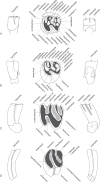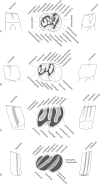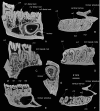Morphology of an Early Oligocene beaver Propalaeocastor irtyshensis and the status of the genus Propalaeocastor
- PMID: 28533963
- PMCID: PMC5436589
- DOI: 10.7717/peerj.3311
Morphology of an Early Oligocene beaver Propalaeocastor irtyshensis and the status of the genus Propalaeocastor
Abstract
The Early to Late Oligocene Propalaeocastor is the earliest known beaver genus from Eurasia. Although many species of this genus have been described, these species are defined based on very fragmentary specimens. Propalaeocastor irtyshensis from the Early Oligocene Irtysh River Formation in northwestern Xinjiang, China is one of the earliest-known members of Propalaeocastor. This species is defined on a single maxillary fragment. We revise the diagnosis of P. irtyshensis and the genus Propalaeocastor, based on newly discovered specimens from the Irtysh River Formation. The dental morphology of P. irtyshensis is very similar to other early castorids. The caudal palatine foramen of P. irtyshensis is situated in the maxillary-palatine suture. This is a feature generally accept as diagnostic character for the castorids. On the other hand, P. irtyshensis has two upper premolars, a rudimentarily developed sciuromorph-like zygomatic plate, and a relatively large protrogomorph-like infraorbital foramen. Some previous researchers suggested that Propalaeocastor is a junior synonym of Steneofiber, while other took it as a valid genus. Our morphological comparison and phylogenetic analysis suggest that Propalaeocastor differs from Steneofiber and is a valid genus. We also suggest that Agnotocastor aubekerovi, A. coloradensis, A. galushai, A. readingi, Oligotheriomys primus, and "Steneofiber aff. dehmi" should be referred to Propalaeocastor. Propalaeocastor is the earliest and most basal beaver. The origin place of Propalaeocastor and castorids is uncertain. The Early Oligocene radiation of castorids probably is propelled by the global climate change during the Eocene-Oligocene transition.
Keywords: Beavers; Early Oligocene; Irtysh River Formation; Propalaeocastor; Xinjiang.
Conflict of interest statement
The authors declare there are no competing interests.
Figures









Similar articles
-
The oldest semi-aquatic beaver in the world and a new hypothesis for the evolution of locomotion in Castoridae.R Soc Open Sci. 2022 Aug 24;9(8):220926. doi: 10.1098/rsos.220926. eCollection 2022 Aug. R Soc Open Sci. 2022. PMID: 36016911 Free PMC article.
-
First castorid (mammalia, rodentia) from the middle miocene of southeast Asia.Naturwissenschaften. 2011 Apr;98(4):315-28. doi: 10.1007/s00114-011-0769-0. Epub 2011 Mar 1. Naturwissenschaften. 2011. PMID: 21360164
-
Re-evaluation of Sinocastor (Rodentia: Castoridae) with implications on the origin of modern beavers.PLoS One. 2010 Nov 15;5(11):e13990. doi: 10.1371/journal.pone.0013990. PLoS One. 2010. PMID: 21085579 Free PMC article.
-
Bird evolution in the Eocene: climate change in Europe and a Danish fossil fauna.Biol Rev Camb Philos Soc. 2006 Nov;81(4):483-99. doi: 10.1017/S146479310600707X. Epub 2006 Aug 8. Biol Rev Camb Philos Soc. 2006. PMID: 16893476 Review.
-
Brachiopods from the Silberberg Formation (Late Eocene to Early Oligocene) of Atzendorf, Central Germany.Palaontol Z. 2015;89(4):673-688. doi: 10.1007/s12542-015-0262-8. Epub 2015 May 22. Palaontol Z. 2015. PMID: 28596621 Free PMC article. Review.
Cited by
-
Sciuromorphy outside rodents reveals an ecomorphological convergence between squirrels and extinct South American ungulates.Commun Biol. 2019 Jun 3;2:202. doi: 10.1038/s42003-019-0423-5. eCollection 2019. Commun Biol. 2019. PMID: 31231692 Free PMC article.
-
The oldest semi-aquatic beaver in the world and a new hypothesis for the evolution of locomotion in Castoridae.R Soc Open Sci. 2022 Aug 24;9(8):220926. doi: 10.1098/rsos.220926. eCollection 2022 Aug. R Soc Open Sci. 2022. PMID: 36016911 Free PMC article.
References
-
- Bendukidze OG. Small mammals from the Miocene of southwestern Kazakhstan and Turgai. Davitashvili Institute of Paleobiology, Georgian Academy of Science; Tbilisi: 1993.
-
- Bendukidze OG, De Bruijn H, Van Den Hoek Ostende LW. A revision of Late Oligocene associations of small mammals from the Aral Formation (Kazakhstan) in the National Museum of Georgia, Tbilissi. Palaeodiversity. 2009;2:343–377.
-
- Borisoglebskaya MB. A new genus of beavers from the Oligocene of Kazakhstan. Byulleten Moskovskogo Obshchestva Ispytaleley Prirody, Otdel Biologicheskiy. 1967;72:129–135.
LinkOut - more resources
Full Text Sources
Other Literature Sources

